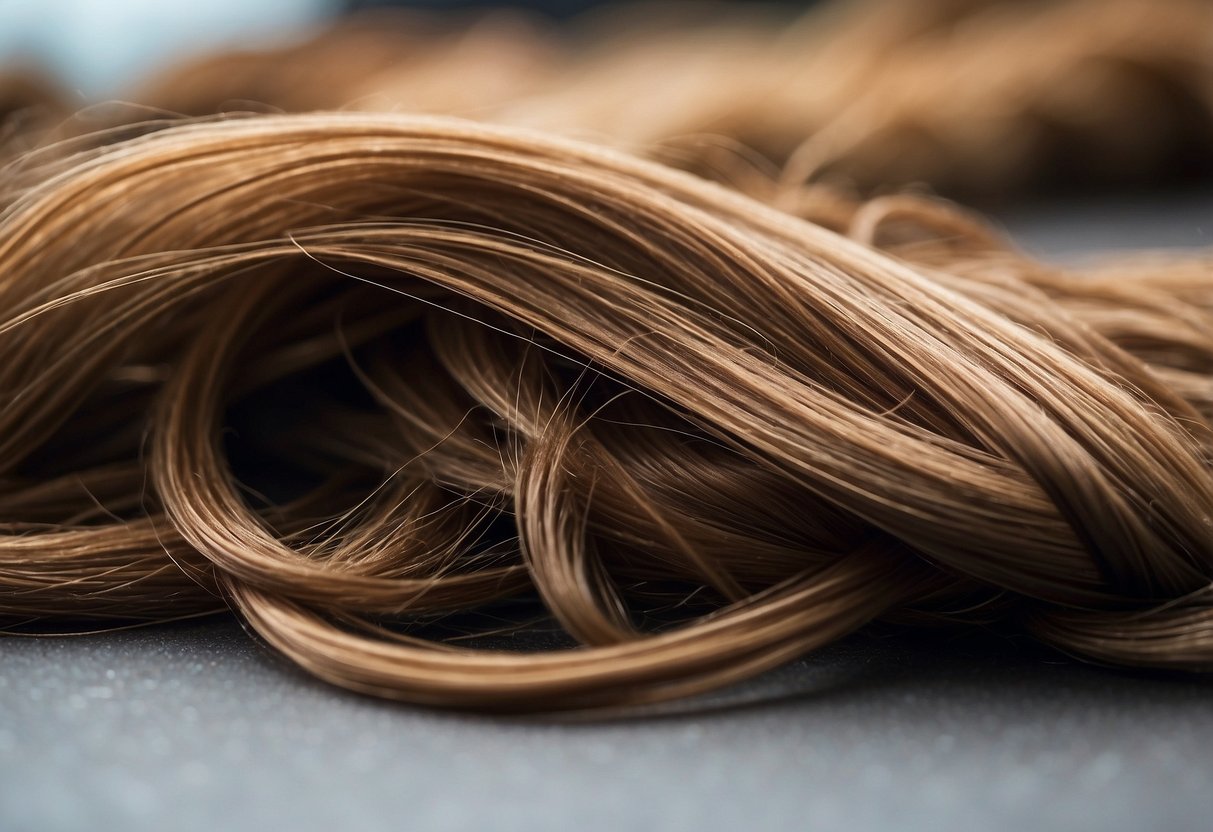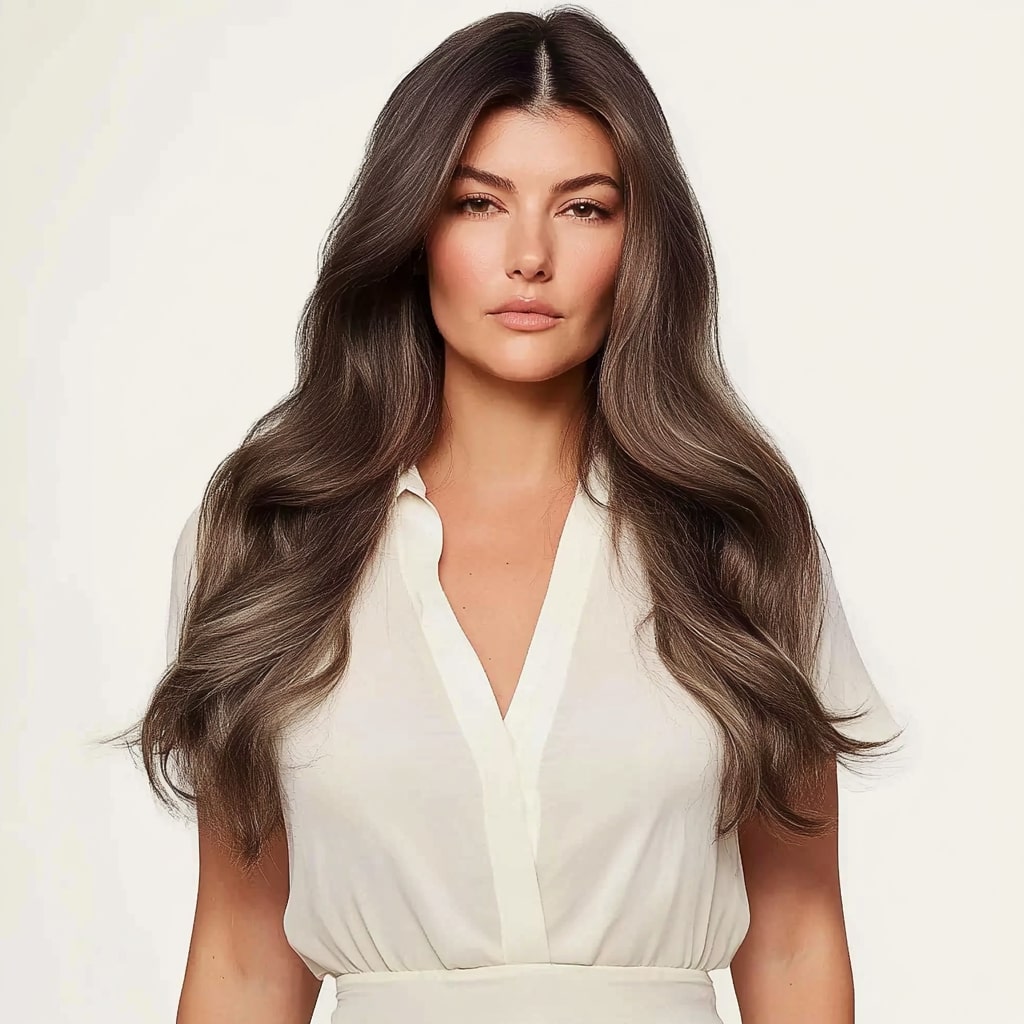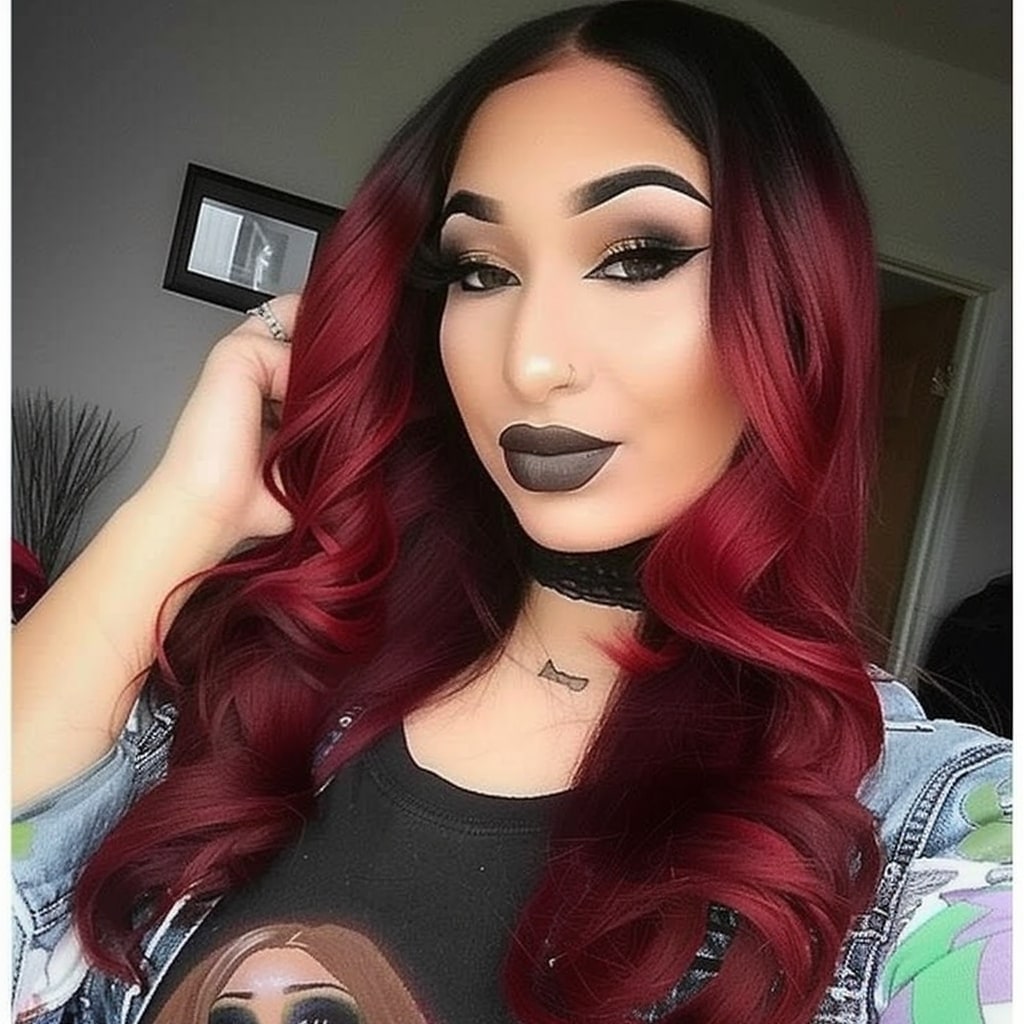Managing Sticky Tape-In Extensions: Causes and Solutions

Tape-in hair extensions offer a natural and convenient way to enhance one's hair, but they can sometimes become sticky and problematic. This stickiness often results from various factors, such as the buildup of oils from shampoos and styling products or the use of low-quality adhesive tape. Excess water or sweat trapped in the tapes can also contribute to this issue, making the extensions hard to manage.
Addressing these causes is crucial for maintaining the quality and appearance of tape-in extensions. Choosing high-quality tapes and following proper care techniques can prevent such problems. By understanding the factors that affect the stickiness of the extensions, individuals can enjoy longer-lasting and more beautiful hair enhancements.
Key Takeaways
- Sticky extensions are usually caused by oil and water exposure.
- High-quality tape and proper maintenance are essential.
- Addressing these issues can help you maintain better extensions.
Tape-In Extensions
What Are Tape-In Extensions
Tape-in extensions are a type of hair extension that attaches to natural hair using medical-grade adhesive. These extensions typically come in small sections, about 1 to 1.5 inches wide. The adhesive is robust, holding the extensions securely without causing damage. The application method involves sandwiching the natural hair between two extension pieces, resulting in a flat and seamless appearance. This technique ensures the extensions blend naturally and move with the hair.
Key Features:
- Width: 1 to 1.5 inches
- Adhesive: Medical-grade, strong and safe
- Application: Sandwich method for natural movement
Advantages of Using Tape-In Extensions
One of the key advantages of tape-in extensions is their natural look. The thin adhesive bonds lie flat against the scalp, making them virtually undetectable when applied correctly.
Main Benefits:
- Natural Appearance: Seamless blend with natural hair
- Long-Lasting: Stays in place for several weeks with proper care
- Comfortable: Lightweight and non-bulky
Another benefit is the ease of maintenance. Tape-in extensions can be styled like natural hair, allowing for regular styling routines without hassle. This makes them an excellent option for those who want a blend of easy maintenance and flexibility.
Parts of Tape-In Extensions
The main parts of tape-in extensions include the hair itself and the adhesive tape. The quality of these components determines the durability and appearance of the extensions.
Hair Quality:
- Human Hair: Preferred for its natural look and feel
- Synthetic Hair: A more affordable option, may not blend as well
Adhesive Tape:
- Medical-Grade Adhesive: Ensures a strong bond, safe for natural hair
- High-Quality Tape: Reduces slippage and keeps extensions in place
Investing in high-quality hair and adhesive is essential for achieving the best results. Lower-quality materials can result in issues such as sticky residue or extensions that fall out. Regularly replacing the tape every 6 to 8 weeks is crucial to maintain the bond’s integrity.
By understanding these aspects, it becomes clear why tape-in extensions are a popular choice for enhancing hair length and volume.
Proper Application Techniques
Preparing Your Natural Hair
Begin by ensuring your natural hair is clean and dry. Use shampoo and conditioner that are free of oils and silicones, as these can prevent the tape adhesives from sticking effectively. Avoid heavy products that can leave residue.
After washing, thoroughly dry your hair. A clarifying shampoo can help remove any buildup. Brush your hair thoroughly to eliminate tangles or knots, making the application process smoother and more efficient.
Dividing and Placing Hair Sections
Divide your hair into small, manageable sections. Use clips to hold each section apart from the area you are working on. Starting at the nape of the neck, work your way upwards.
Ensure the extensions are placed about ¼ to ½ inch away from the scalp. This distance helps to prevent tension on your natural hair. The extensions should be sandwiched between thin slices of your own hair to create a seamless, natural look.
Securing the Adhesive Bonds
Press firmly on each tape-in extension to secure the bonds. Use a flat iron on a low heat setting to seal the adhesive, as some tapes are heat-activated for additional security. Apply consistent pressure to ensure even bonding.
Be cautious not to touch the adhesive with your fingers, as oils from your skin can interfere with the adhesive quality. Always follow the manufacturer’s guidelines regarding the amount of pressure and heat to apply.
Addressing Common Application Errors
Extensions may occasionally slip or fail to stick properly. This can result from improper cleaning of the natural hair before application or using the wrong type of tape for your hair type. If issues arise, always review your preparation steps.
Ensure that sections are being divided correctly and that a consistent distance from the scalp is maintained. Placing extensions too close to the scalp can cause pulling and damage. Proper placement and consistent technique are key to extending the life of your extensions.
Care for Tape-In Extensions
Daily Maintenance
Brush tape-in extensions gently at least twice a day using a soft-bristle brush. Start from the ends and work upwards to avoid pulling on the tapes. Refrain from using heavy styling products near the tapes, as they can cause build-up and weaken the adhesive. Instead, light serums or leave-in conditioners can be applied sparingly to keep the extensions smooth.
When it is time for bed, tie your hair in a loose braid or ponytail to prevent tangling. For additional protection, consider using a silk pillowcase to reduce friction that can damage the hair.
Washing and Conditioning
Choose sulfate-free shampoos to wash your hair, as sulfates can strip the adhesive from the tapes. Apply shampoo primarily to the roots and gently massage, without tugging on the tapes. Rinse thoroughly with lukewarm water. Use a lightweight conditioner, applying it from mid-length to the ends while avoiding the tape area to maintain adhesion.
A deep conditioning treatment once a week can help, but be careful to avoid the tapes. After washing, pat your hair dry with a towel instead of rubbing it, which can create frizz and disturb the tapes. Let your hair air dry or use a blow dryer on a low heat setting, keeping it at a distance to prevent overheating the adhesive.
Handling Slipping or Stickiness Issues
If extensions show signs of slipping or stickiness, poor adhesion could be due to low-quality tape. It is beneficial to use professional-grade tapes designed specifically for hair extensions. Clean hair free from oils or residues before applying the extensions to ensure optimal adhesion.
If extensions become sticky after several weeks, consider retaping them. Remove the old tape, clean the extension, and apply new adhesive. Regular appointments with a stylist can help address and prevent such issues promptly.
Hair and Scalp Health

Impacts of Tape-In Extensions on Scalp
Tape-in extensions, if not managed properly, can affect the health of the scalp. These extensions are attached near the scalp, which can sometimes cause irritation. Using strong adhesives repeatedly can make this worse.
The weight of the extensions can stress the scalp, causing discomfort or even mild pain. If not removed correctly, the scalp can suffer damage, leading to abrasions.
Keeping the scalp clean is very important. Regular cleaning can stop oils from building up, which can make the tapes sticky. This buildup can block the hair follicles, leading to issues like itching and dandruff.
Avoiding Damage to Natural Hair
To protect natural hair, it’s important to use high-quality extensions and adhesive tapes. Poor quality materials can cause breakage and make the extensions loose, putting stress on the hair.
Before using extensions, make sure the hair is clean and free from oils and residues. Too much oil can weaken the adhesive, making the extensions likely to slip and become sticky.
Regular care and gentle handling are essential. Avoid rough brushing or pulling on the extensions to prevent hair loss or breakage. Stick to a hair care routine with gentle shampooing and conditioning to maintain the health of both extensions and natural hair.
It’s also important to let the natural hair breathe and grow by avoiding prolonged use of extensions without breaks.
Removing Tape-In Extensions
When It’s Time to Take Out Tape-In Extensions
Tape-in hair extensions should be removed every 6 to 8 weeks. This is to prevent hair damage and maintain scalp health. If left too long, the extensions might start slipping or cause discomfort. Look out for signs like adhesive breakdown or gaps where the tape has come loose.
Steps To Safely Remove Tape-In Extensions
To remove tape-in extensions without harming your natural hair, follow these steps:
-
Get Your Tools Ready: You will need an adhesive remover, a fine-tooth comb, and an alcohol-based solution to dissolve the adhesive.
-
Apply Adhesive Remover: Put the adhesive remover directly on the tape tabs. Make sure it covers the adhesive completely.
-
Wait: Allow a few minutes for the remover to break down the adhesive.
-
Comb Gently: Use a fine-tooth comb to separate the extensions from your hair. Be gentle and avoid pulling to prevent hair damage.
If these steps feel too tricky, consider getting professional help for a safer process.
Hair Care After Taking Out Tape-In Extensions
Proper aftercare is essential once the extensions are removed:
-
Thoroughly Cleanse Your Hair: Use a mild clarifying shampoo to get rid of any leftover adhesive. Follow this with a deep conditioning treatment to restore moisture to your hair.
-
Avoid Harsh Treatments: Do not use harsh chemicals or heat styling tools for a few days. This break helps your natural hair recover strength.
Taking time for these aftercare steps will help maintain a healthy scalp and strong hair, making it ready for future extensions or other styles.
Preventing and Fixing Sticky Tape-In Extensions

Avoiding Sticky Extensions
Stay Clear of Oils and Product Build-Up: Oils and heavy hair products can cause tape-in extensions to become sticky. Oils from the scalp or certain styling products weaken the adhesive, leading to stickiness and slippage.
Use Cleansing Shampoo: Cleansing hair with a sulfate-free shampoo removes product build-up without harming the extensions. Sulfate-free shampoos are gentle and preserve the essential oils in both natural hair and extension tapes.
Keep Hair Dry: Moisture weakens adhesive bonds. Thoroughly drying hair after washing prevents tape sections from becoming weak. Using a blow dryer on a safe heat setting helps ensure the tapes remain secure.
Immediate Solutions for Sticky Tape-Ins
Change the Tape: When extensions become sticky, it's often necessary to replace the old tape. Using high-quality replacement tape designed for extensions helps maintain a strong bond. Regular tape replacement every 6 to 8 weeks ensures bond integrity.
Clean the Tape Areas: Cleaning the areas where the tapes adhere is essential. Use a non-oily adhesive remover to clean any residue on the tapes, ensuring the new tape sticks effectively.
Avoid Heat and Moisture: Keep tape-in extensions away from excessive heat and moisture. Avoid activities like hot showers, saunas, and intense workouts that expose extensions to these conditions. Keeping extensions cool and dry enhances adhesive strength.
Consult a Professional: If home solutions aren’t effective, visiting a professional stylist can help. Professionals can apply specialized tape-in extension care, ensuring the extensions are securely attached and well-maintained.
By following these tips, unwanted stickiness in tape-in extensions can be prevented and quickly resolved.
Choosing the Best Products
Using the Right Cleansing Agents
Cleansing Shampoo: Choose a shampoo designed specifically to remove buildup. This type keeps extensions clean without harming the adhesive.
Sulfate-Free Shampoo: Opt for sulfate-free shampoos since sulfates can weaken the adhesive tape. These shampoos clean without stripping natural oils or leaving any residue.
Conditioners should be light and only applied to the ends of the hair. Heavy conditioners can cause the tape-ins to slip or become sticky.
Wash your hair gently and avoid scrubbing the tape areas directly.
Products to Avoid with Tape-Ins
Alcohol-Based Products: Steer clear of products containing alcohol. Alcohol can dissolve the adhesive, leading to extensions falling out.
Oils: Avoid using oils directly on the tape-in area as they can break down the adhesive over time.
Sticky or Heavy Styling Products: Use these products sparingly. Heavy and sticky styling items can cause buildup, making extensions tacky and hard to manage.
Regularly check the ingredient labels to ensure that none of the products will compromise the effectiveness of the tape-ins. Choose quality products to maintain both your natural hair and extensions.
Consulting a Professional
When tape-in extensions become sticky, consulting a professional hair stylist can be very helpful. A licensed stylist can closely examine the extensions and identify the causes of the stickiness, which might not be noticeable to the untrained eye.
Visiting a salon has many advantages. Professionals there use high-quality products and techniques for both applying and removing tape-in extensions. They are skilled in addressing issues like stickiness, often caused by incorrect application or poor-quality tape.
If the extensions are falling out, a hair stylist can recommend the right type of tape specifically designed for tape-in extensions. Regular visits to the salon also help in maintaining the extensions in good condition, ensuring they stay free from residue and stickiness.
A thorough cleaning routine suggested by a hair stylist will be beneficial, covering both natural hair and extensions. They know which products to use and can advise on avoiding common mistakes that lead to sticky buildup. For more complex issues, the stylist might recommend a different type of extension that better suits the individual's hair type and lifestyle.
Seeking expert advice not only helps in resolving stickiness but also prolongs the life of tape-in extensions, ensuring they maintain a seamless and natural appearance.
Frequently Asked Questions
Why are my tape-in extensions sticky?
Stickiness in tape-in extensions often occurs due to product buildup or improper cleaning. Residue from shampoos, conditioners, or styling products can accumulate on the tape. It is essential to use products specifically designed for tape-in extensions to avoid this issue.
How can sticky tape-in extensions be removed without damaging hair?
To safely remove sticky tape-in extensions, a specialized tape-in extension remover should be used. Apply the remover to the adhesive area and let it sit for a few minutes to loosen the tape. Carefully peel the tape away from the hair to prevent any damage.
How often should the tape on extensions be replaced?
Tape on extensions should generally be replaced every 6 to 8 weeks. The exact timing depends on the natural hair growth rate and the bond’s integrity. Regular replacements ensure a strong bond and prevent extensions from slipping.
What steps ensure tape-in extensions stick better?
Several steps can be taken to improve the adherence of tape-in extensions:
- Use high-quality tape made for tape-in extensions.
- Ensure hair is clean and free of oils or conditioners before application.
- Press and hold the tape firmly for at least 10 seconds to secure a strong bond.
Are tape-in extensions harmful to natural hair?
Tape-in extensions are generally safe if applied and maintained correctly. Using high-quality extensions made from real human hair and following proper care practices will prevent damage to natural hair.
Why do tape-in extensions keep falling out?
Extensions might fall out if the adhesive loses its hold. Causes can include washing the hair too soon after application, using oily or heavy products, or not pressing the tape firmly enough when applying. Taking these factors into account can help maintain the extensions.
Quick Tips:
- Customer Service: For any issues or further questions, contact customer service for expert advice and assistance.
- Maintenance: Regularly check the tape bonds and ensure they are securely attached.
- Product Choice: Always select products tailored for use with tape-in extensions to maintain their adhesion and longevity.
Frequently Asked Questions
Why do tape-in hair extensions get sticky after washing?
Tape-in hair extensions can become sticky after washing due to remaining product build-up or wrong washing methods. Shampoos and conditioners that contain oils or silicone might leave behind a sticky residue. It's crucial to use products specifically made for extensions.
What is the best way to clean sticky residue from tape-in hair extensions?
To clean sticky residue, an alcohol-based extension remover or gentle adhesive remover is recommended. Apply the remover on the sticky spots and gently comb through the extensions to remove any residue.
How can one stop tape-in extensions from slipping?
Proper application and care are essential to stop tape-in extensions from slipping. Use only top-notch adhesive tape and avoid applying conditioners or oils near the tape. Regularly check the bond and replace the tape every 6 to 8 weeks.
How can dry and sticky tape-in extensions be softened?
For softening dry and sticky tape-in extensions, apply a lightweight, silicone-free leave-in conditioner sparingly. Avoid heavy products that could weigh down the extensions and make them sticky again.
Why might tape-in extensions feel sticky on the sides?
Tape-in extensions might feel sticky on the sides if not sealed correctly during application or if hair products build up there. Ensure the extensions are properly attached and limit the use of heavy styling products near the tapes.
Is slippage a frequent problem with tape-in hair extensions?
Yes, slippage is a common problem with tape-in extensions, often occurring when the application process isn't done correctly. Using suitable products and techniques helps maintain secure bonds and lessens slippage.
Frequently Asked Questions
Methods to Stop Tape-In Hair Extensions from Slipping
To keep tape-in hair extensions from slipping, it is crucial to use high-quality tape and prep your natural hair well. Wash your hair thoroughly to remove any oils or residue before applying the extensions. Avoid using conditioners near the roots as they can make the tapes less sticky. Make sure that the extensions are applied to clean, dry hair, and press firmly to ensure the tape sticks well.
Frequency of Reusing Tape-In Extensions Without Losing Quality
Tape-in extensions can be reused multiple times if handled with care. Typically, it is recommended to replace the tape and reapply every 6 to 8 weeks depending on your hair growth. Always use a gentle remover to avoid damaging the hair and ensure that each reapplication is done meticulously to maintain the quality of the extensions.
Effective Methods for Removing Tape-In Hair Extensions
Removing tape-in hair extensions can be done without causing damage to your hair. Use a specialized adhesive remover designed for tape-in extensions. Apply it generously on the tape section and gently separate the extensions from your natural hair. Patience is key; avoid pulling to prevent hair loss.
Longevity of Tape-In Hair Extensions with Proper Care
With the right care, tape-in hair extensions can last from 6 to 8 weeks per application. Proper care involves regular gentle washing, brushing, and using products that do not contain sulphates or alcohol. Avoid using heavy oils or silicone-based products near the roots to keep the adhesive strong.
Best Ways To Remove Sticky Residue From Hair After Tape-In Extension Removal
After removing tape-in extensions, you may find sticky residue left on your natural hair. To remove it, apply a residue remover or use natural oils like coconut or olive oil. Let it sit for a few minutes, then comb through the hair carefully. Wash your hair properly afterward to ensure all the residue is gone.
Recommended Tape-In Extension Brands for Black Hair Textures
Certain tape-in extension brands are specially formulated for Black hair textures. When choosing extensions, look for brands that offer a variety of textures and lengths, such as KinkyCurlyYaki, Indique, and Her Given Hair. These brands are known for providing high-quality, natural-looking extensions suitable for Black hair.

 My Store Credit
My Store Credit
 Buy Again
Buy Again






